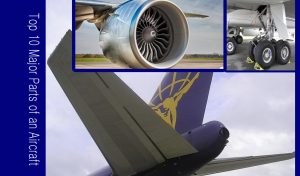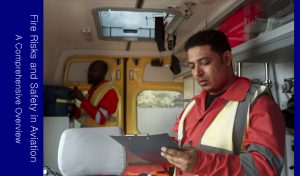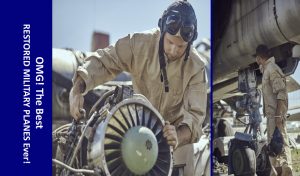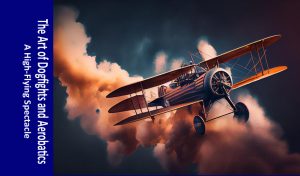Welcome to a journey that takes us back in time, a journey that’s not just about aviation but about history, courage, and the thrill of the skies. It’s a journey through the captivating world of Vintage Warbirds. So be with us while Exploring the Fascinating World of Vintage Warbirds.
The Birth of Legends
The Pioneering Days of Aviation Warfare
In the early 20th century, a new era was dawning. It was a time of daring pioneers, a time when aviation became synonymous with warfare. Let’s explore the remarkable birth of these legends.
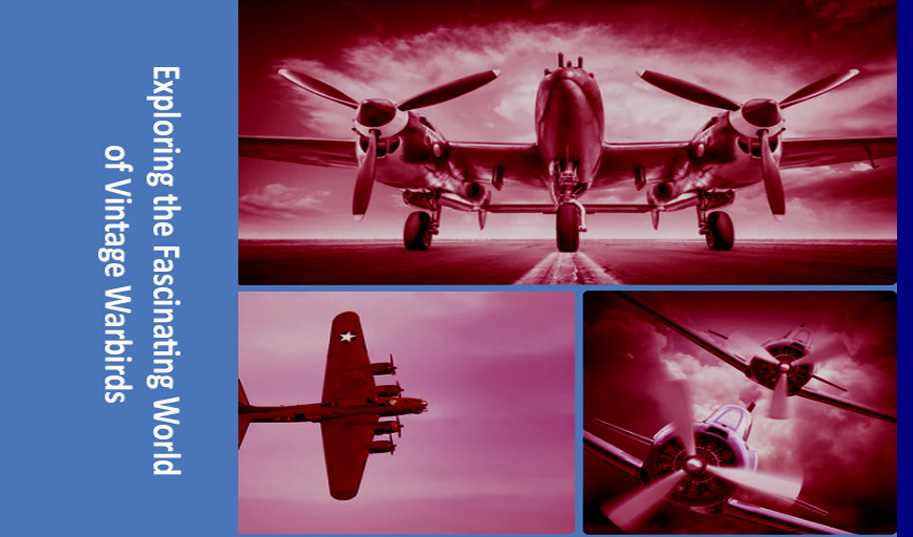
A Symphony of Metal and Dreams
The Vintage Warbirds Collection
Imagine walking into a hangar filled with meticulously restored vintage aircraft. Each plane whispers a story, and together, they create a symphony of metal and dreams. Let’s take a closer look at some of the most iconic Vintage Warbirds that have stood the test of time.
Spitfire – The Unconquerable Spirit
Defying the Odds in the Battle of Britain
The Spitfire, with its distinctive elliptical wings and legendary performance, symbolizes the indomitable spirit of its era. Let’s embark on a flight back in time to the Battle of Britain and witness how this fighter plane defied all odds.
P-51 Mustang – The Cadillac of the Sky
From Escort Duty to Racing Glory
When it comes to World War II fighter aircraft, the P-51 Mustang stands out as a true legend. Often dubbed “The Cadillac of the Sky,” this aircraft’s features, technologies, manufacturing processes, and specialties set it apart from the rest. In this article, we’re going to take a deep dive into the world of the P-51 Mustang and explore what makes it such an extraordinary piece of aviation history.
The Birth of a Legend
The P-51 Mustang, designed and built by North American Aviation, emerged as a game-changer during World War II. Let’s explore the key elements that contributed to its legendary status.
Design and Features
The P-51 Mustang’s design was a masterpiece in aerodynamics and functionality. Its streamlined form was not just aesthetically pleasing, but it also had a significant impact on performance.
Streamlined Aesthetics
The Mustang’s low-wing monoplane design gave it an elegant look, while its bubble canopy improved the pilot’s visibility, making it easier to spot enemies in the sky.
Laminar Flow Wing
The laminar flow wing, a technical marvel of its time, reduced drag, resulting in exceptional aerodynamic efficiency. It allowed the Mustang to reach incredible speeds.
Powerplant
A fighter aircraft’s heart lies in its engine. The Mustang had not one, but two noteworthy powerplants in its history.
The Early Days: Allison V-1710
In its early models, the Mustang was powered by the Allison V-1710 engine, which provided reasonable performance. However, it was the next engine that truly catapulted the Mustang into stardom.
Rolls-Royce Merlin Engine
When equipped with the Rolls-Royce Merlin engine, the Mustang’s performance soared to new heights. This engine, known for its reliability and power, enabled the Mustang to reach a top speed of approximately 437 mph, making it a force to be reckoned with.
Performance
The Mustang’s performance was nothing short of spectacular, which played a pivotal role in its success on the battlefield.
Speed and Altitude
With its top speed, the Mustang could outpace many of its contemporaries, and its high-altitude performance was unmatched, making it a formidable asset in air combat.
Extended Range
One of the standout features of the P-51 Mustang was its remarkable range. This extended range allowed it to escort bombers deep into enemy territory, a vital strategic advantage.
Armament
A fighter aircraft’s firepower is a crucial aspect of its effectiveness in combat, and the Mustang was not lacking in this department.
Firepower Dominance
Armed with six .50 caliber M2 Browning machine guns, the Mustang had an impressive advantage in firepower over many enemy aircraft, ensuring it could hold its own in dogfights.
Versatility in Armament
In addition to its machine guns, some variants of the Mustang had the capability to carry bombs or rockets, making it a versatile asset in ground attack roles as well.
Manufacturing
The success of the P-51 Mustang wasn’t just due to its design and performance; it was also the result of efficient manufacturing processes.
American Industrial Might
The manufacturing of the Mustang became a symbol of American industrial prowess during World War II. With the collaboration of various companies, the production process was streamlined to meet the high demand.
Specialty and Legacy
What set the P-51 Mustang apart from other aircraft was its ability to excel in a variety of roles, leaving an indelible mark on aviation history.
Air Superiority
The Mustang’s role in achieving air superiority over Europe during World War II cannot be overstated. It played a critical part in turning the tide of the war.
Long-lasting Impact
Even after World War II, the P-51 continued to serve in various capacities, including air racing. Its legacy as a symbol of American aviation excellence remains intact.
B-17 Flying Fortress – The Heavy Bomber
A Glimpse into the Perils of Bomber Crews
In the annals of aviation history, few aircraft have left as profound a mark as the B-17 Flying Fortress. Revered as “The Heavy Bomber,” this colossal warbird boasts a remarkable amalgamation of features, technologies, manufacturing prowess, and specialties that set it apart. In this article, we embark on a journey to unveil the incredible story of the B-17 Flying Fortress.
A Fortress Takes Flight
The B-17 Flying Fortress, an iconic symbol of American air power, represents a pinnacle in heavy bomber design and functionality. Let’s delve into the key aspects that define its legacy.
Design and Features
The B-17’s design and features weren’t merely functional; they were a testament to meticulous engineering and innovation.
Fortified Design
The Flying Fortress earned its moniker with a robust and well-armored design. It featured multiple gun turrets, earning it a reputation for being a tough nut to crack in aerial combat.
Strategic Bombing
Its ability to carry a significant payload made it an ideal choice for strategic bombing missions. The B-17 could rain devastation on enemy targets with its precision bomb-dropping capabilities.
Powerplant
Powering this behemoth was an array of engines that ensured it could reach its intended targets and return safely.
Four-Engine Power
The B-17 was equipped with four powerful radial engines, which not only provided the necessary thrust but also redundancy – a crucial feature for long, perilous missions.
Turbocharging
Advanced turbocharging technology enabled the Flying Fortress to reach high altitudes and escape interception, ensuring its payload delivery.
Performance
The B-17’s legendary status is attributed to its exceptional performance in the theater of war.
Cruising Range
One of the standout features was its impressive cruising range. The B-17 could cover extensive distances, making it a formidable asset in both the European and Pacific theaters of World War II.
Survivability
The Flying Fortress’s ability to absorb enemy fire and still continue its mission made it a valuable asset in the face of relentless anti-aircraft defenses and enemy fighters.
Armament
The B-17’s firepower was unparalleled among its contemporaries, and it was often referred to as a “flying fortress” for good reason.
Defensive Arsenal
With multiple gun turrets and machine guns, the B-17 had a formidable defensive armament. It could fend off enemy fighters with a barrage of bullets from all angles.
Bomb Load
The B-17 could carry a substantial bomb load, delivering destruction precisely where it was needed most. Its high-altitude bombing capabilities were vital in strategic operations.
Manufacturing
The mass production of the B-17 was a remarkable feat that showcased American industrial might during World War II.
Mass Production
Manufactured by Boeing, Douglas, and Lockheed, the B-17 was produced in substantial numbers. The collaboration between various companies streamlined production to meet the rising demand.
Efficient Production Lines
Efficiency was the name of the game, as factories churned out B-17s with remarkable speed, equipping Allied forces with a formidable bomber fleet.
Specialty and Legacy
The B-17 Flying Fortress wasn’t just another bomber; it was a symbol of strategic air power and resilience in the face of adversity.
Strategic Role
The B-17 played a crucial role in the Allied strategic bombing campaigns in Europe, significantly weakening the enemy’s industrial and military capabilities.
Enduring Legacy
Even after World War II, the B-17 continued to serve in various roles, including transport and reconnaissance. Its legacy as a symbol of American aviation prowess remains intact.
The Thrills of Vintage Warbird Flying
Where to Experience the Roar of the Past
Now that we’ve journeyed through history, let’s focus on the present. Where can you witness these Vintage Warbirds up close? We’ll guide you to the best airshows, museums, and events where the magic of these aircraft comes to life.
Soaring Through Time
What It Feels Like to Fly in a Vintage Warbird
Have you ever wondered what it’s like to sit in the cockpit of a Vintage Warbird? Buckle up as we describe the exhilaration of soaring through time in one of these historic machines.
The Restoration Heroes
Behind the Scenes of Vintage Warbird Preservation
These beautiful birds don’t maintain themselves. Discover the passionate individuals and teams dedicated to the restoration and preservation of Vintage Warbirds.
Conclusion
As our journey through the skies and history comes to a close, we hope you’ve gained a newfound appreciation for Vintage Warbirds. These iconic aircraft aren’t just machines; they represent the pinnacle of aviation technology of their time and stand as enduring symbols of courage, innovation, and the human spirit.
FAQs (Frequently Asked Questions)
1. How can I attend airshows featuring Vintage Warbirds?
You can check the event listings of popular airshows, such as EAA AirVenture Oshkosh and the Flying Legends Airshow. Many aviation museums also host special events with Vintage Warbird displays.
2. Are Vintage Warbird flights safe for passengers?
Vintage Warbird flights are generally safe, as they are meticulously maintained. However, it’s important to follow safety instructions provided by the flight crew.
3. Can I volunteer for Vintage Warbird restoration projects?
Certainly! Many aviation museums and organizations welcome volunteers to help restore and maintain these historic aircraft. It’s a fantastic way to get hands-on experience.
4. What’s the cost of taking a flight in a Vintage Warbird?
The cost of a Vintage Warbird flight can vary depending on the aircraft, duration, and location. On average, prices can range from a few hundred to a few thousand dollars.
5. Can I book a private flight in a Vintage Warbird?
Some organizations offer private Vintage Warbird flights, often for special occasions like anniversaries or birthdays. These experiences can be tailored to your preferences.
Prepare to be awed, inspired, and transported to an era of heroics and innovation as you explore the world of Vintage Warbirds. Whether you’re an aviation enthusiast, a history buff, or simply seeking an extraordinary adventure, these legendary aircraft have something truly special to offer. Don’t miss your chance to be part of their enduring legacy.
Note: Also you may interested to know about different iconic warbirds.
